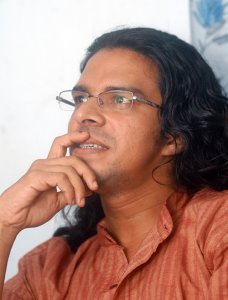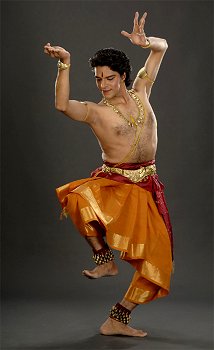
|
 |

|
 |
Sheejith Krishna: I serve my Alma matter and enjoy that - Lalitha Venkat December 9, 2008  Sheejith Krishna, a dancer and choreographer, was initiated into dance from the early age of eight. He had behind him for guidance, his father Kannur Balakrishnan, a Bharatanatyam and Folk dance artiste and Director of 'Noopuram,' a school of Fine Arts in Kerala. Also inspiring him was his mother Manorama Balakrishnan, a Bharatanatyam and Mohiniyattam artiste herself. His initial training began under the tutelage of his parents. He honed his skills further by learning mridangam under Kalamandalam Ramakrishnan and under the able tutorship of Ghatam Vidwan T H Vinayakaram and T R Sundaresan. His quest for knowledge in the art field brought him to Rukmini Devi's world famous institution Kalakshetra. Apart from rigorous training in Bharatanatyam, Sheejith Krishna also nourished his vocal talent under S Rajaram (Director of Kalakshetra) and Salem Chellam Iyengar. After his 4-year diploma course, he continued with his post graduation in Bharatanatyam and passed out achieving a first class from the same institution. He is now a faculty member at Kalakshetra. How does Rukmini Devi Arundale perceive Ravana in her choreography? How would you? The belief that Ravana was a great Vedic scholar and musician is supported by both the earlier and later portions of the epic. Ravana's court expounded the philosophy of four purusharthas (objects of life) - Dharma, Artha, Kaama and Moksha. Keeping this in mind I believe that Rukmini Devi also might have portrayed Ravana in her Ramayana series as mentioned above. In any case, the Rakshasas were strong and tall in stature. In stories or pictures we witness demons with teeth sticking out, horns on head and somewhat ugly in look. Rukmini Devi gave regular striking and handsome features to Ravana in all four series of dance dramas (as described in the epics). She used Kathakali technique in all her major productions. This technique was used for example when vigorous action, characterization of non human (Ravana, Hanuman etc) or elaborate miming was required. In the Natya Kala conference, my duty as a dancer is to portray the character of Ravana the way Rukmini Devi visualized and choreographed. My ultimate aim is to do justice to the character portraying with my experience by watching veteran gurus Janardhanan and Balagopalan, and later depicting these characters made me realize more about her great sense of choreography direction, aesthetic sense, understanding, presentation skill and as an artiste on the whole. As a Kalakshetra teacher, what aspect of Ramayana themes do you think can still be explored? I feel the main content for editing of the episodes is well planned and presented through 6 series of Ramayana (Kalakshetra productions). Still if you look for explanations, the Maha Kavya Ramayana will give you room to do it. For example, the domination of the male characters has suppressed some of the strong female characters and their sacrifices in courage, pain, intellect, etc. You recently presented Sri Ram Katha based on Saint Tulsidas' Ramcharitamanas choreographed to OS Arun's bhajans. How did that come about and do you plan more such programs? There are two important points about that production Sri Rama Katha (Bhajananarthanamruthan). The first is the happiness of dancing while OS Arun sings. I just adore his music, especially the bhajans. The whole production music is set in bhajan style and dancing to it with my co - dancer Suhasini Thomas (product of Kalakshetra and faculty member) was a great achievement. We both portrayed the characters like Nara to Varana, Sita to Surpanaka and Rama to Ravana. That was our challenge and it was well received, welcomed and appreciated by the audience. If opportunities come, I will be performing more. You have choreographed a new production 'Masquerade' that is quite a deviation from traditional themes of Kalakshetra. Comment. The art of Bharatanatyam belongs to Tamilnadu in its origin and is famous world wide. As a Bharatanatyam artiste, it's my language, one that's accepted, understood and appreciated in all corners of the world. The theme is European, but I believe, we can convey any theme through any language, and that's all I looked for. The Kalakshetra productions of Rukmini Devi, when conceived and presented, was quite different from traditional presentations; many people at that time may had looked at it as contemporary. Now those productions are considered as traditional, particularly the costumes, lighting, presentation style, etc. 'Masquerade-Man in the iron mask' is a theme different from our kavyas and other epics, but when you look at it just as a theme or a story, my presentation took place within my well established grammar language of Bharatanatyam. Kathakali was used by Rukmini Devi in her dance dramas; I used ballet movements, understanding the flavour of the theme of Masquerade. (Just as an example, not to compare my work or myself with the legendary Rukmini Devi)  Kalakshetra has opened out now, with many different workshops happening, even by contemporary performers like Astad Deboo. How has it helped you all? If one feels that Kalakshetra has opened out, it's definitely a happy comment. Yes, with the leadership of Ms. Leela Samson, a number of workshops and performances took place, but as an artiste I valued all and praise is deserved for all who were behind the arrangement. Kalakshetra opened out, but that doesn't mean the value of the workshops or performances are valued after viewing. We were selective and useful for branching out our knowledge and realisation. Dance or music in general has got divisions with its grammar. When you understand the grammar in presentation, choreography, the art forms are named in different ways; one becomes classical, contemporary, folk, etc. As long as you understand and face the challenge by using its own grammar, maintain it and perform it aesthetically, it will help any dancer to become a complete artiste. That's how it helped us. You are multi-faceted, you are also a percussionist and trained singer. You compose music for dance. Why did you decide to stay on at Kalakshetra as faculty instead of branching out and starting your own institution? I think even if I am out there with my own institution, I may be doing just what I am now - teaching, which I always enjoy, performing, sharing, etc. Of course I may be more available with private works and with the factor of time, but being in Kalakshetra and in that atmosphere, I feel I become a better artiste everyday, every second. For an artiste, you get everything here in this atmosphere. I live with nature, art and creativity. At the moment, I serve my Alma mater and I enjoy that. Let's see what time has in store for me. Your comment about the Chennai December season. A festival with music, dance and other activities, real cheerful and educative season, but one should be able to identify true talent, dedicated artistes both young and senior. The sabhas should stand for values of the artistic productions. An artiste should present himself with deep understanding and should be able to reach out his abilities and art to the audience. In this endeavor, the organisations and the sabhas need to support the artiste. Contact: e-mail: sheejithkrishna@gmail.com |